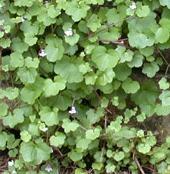 Kenilworth Ivy (Wall Toadflax, Roving Jenny, Pennywort, Mother of
Thousands, Ivywort, Aaron's Beard, Climbing Sailor, Ivy leafed
Toadflax) - Cymbalaria
muralis (syn. Linaria cymbalaria)
Kenilworth Ivy (Wall Toadflax, Roving Jenny, Pennywort, Mother of
Thousands, Ivywort, Aaron's Beard, Climbing Sailor, Ivy leafed
Toadflax) - Cymbalaria
muralis (syn. Linaria cymbalaria)  Kenilworth Ivy (Wall Toadflax, Roving Jenny, Pennywort, Mother of
Thousands, Ivywort, Aaron's Beard, Climbing Sailor, Ivy leafed
Toadflax) - Cymbalaria
muralis (syn. Linaria cymbalaria)
Kenilworth Ivy (Wall Toadflax, Roving Jenny, Pennywort, Mother of
Thousands, Ivywort, Aaron's Beard, Climbing Sailor, Ivy leafed
Toadflax) - Cymbalaria
muralis (syn. Linaria cymbalaria)
Low creeping ground cover plant, member of the Snapdragon family,
Scrophulariaceae. Native to the Mediterranean region of Europe,
Cymabalaria has become naturalized in warmer parts of eastern North
America. It has a trailing habit and spreads by suckers along the
stems. The leaves are slightly triangular in shape with scalloped
edges, dark green and prolific. Tiny snapdragon like blooms are
lilac to purple in color and appear in late spring and last until winter
The plants spread quickly and self seeds as well, and so will
quickly cover a walk, rock garden or slope. When introducing
Cymbalaria into the garden, take these facts into consideration as it
may overwhelm other plants. This vigorous growth makes it ideal
for planting as a walk on ground cover, a wall covering, or in baskets
or containers in sunny or semi shady areas .
Cymbalaria thrives in ordinary garden soil in a sunny or semi shady
location and is not particular about soil type. In cooler
climates, it can be grown as an annual and will usually reseed over
winter, even though the mother plants may die.
Propagation is extremely easy and may be accomplished either by
cuttings, transplanting suckers or by sowing seed. Seed should be
sown in flats or plug trays and pressed lightly into the medium.
Keep moist at 80F and cover with plastic or glass until
germination. Seedlings should be transplanted to larger
containers when they reach about 2 inches in height. Transplant
outdoors when the temperatures have warmed and do not fall below
60F. Space at 12-18 inches apart in a prepared bed or plant in
soil between paving stones or rock walls. Just a cool note: the flower
stalk of the plant is phototropic ( it follows the sun). At
first, before fertilization, it leans the blooms toward the light and
after fertilization moves them away from the light. Seeds are
then shed in the crevices of walls or walks in which it is planted,
thus increasing the chances of seed germination.
Some consider the leaves of the plant to be edible, but the taste is
very bitter and large quantites may be toxic. Leaves have also
been used to treat diabetes and as a poultice to staunch
bleeding.
Hardy to 10F (-17.7C) Height: 4
inches Spread: 18-24 inches
| #1375 Packet $3.50 Approximately 100 seeds |
|
| #BM-1375 Bulk seed 1000 seed
$9.50 |
|
ORDER EARLY!
See TERMS
Back to VARIETY INDEX Terms
HOME
![]() If
you have arrived in someone else's frame, or can not see all of the
other
information available on richfarmgarden.com Click on logo to enter from
beginning
If
you have arrived in someone else's frame, or can not see all of the
other
information available on richfarmgarden.com Click on logo to enter from
beginning